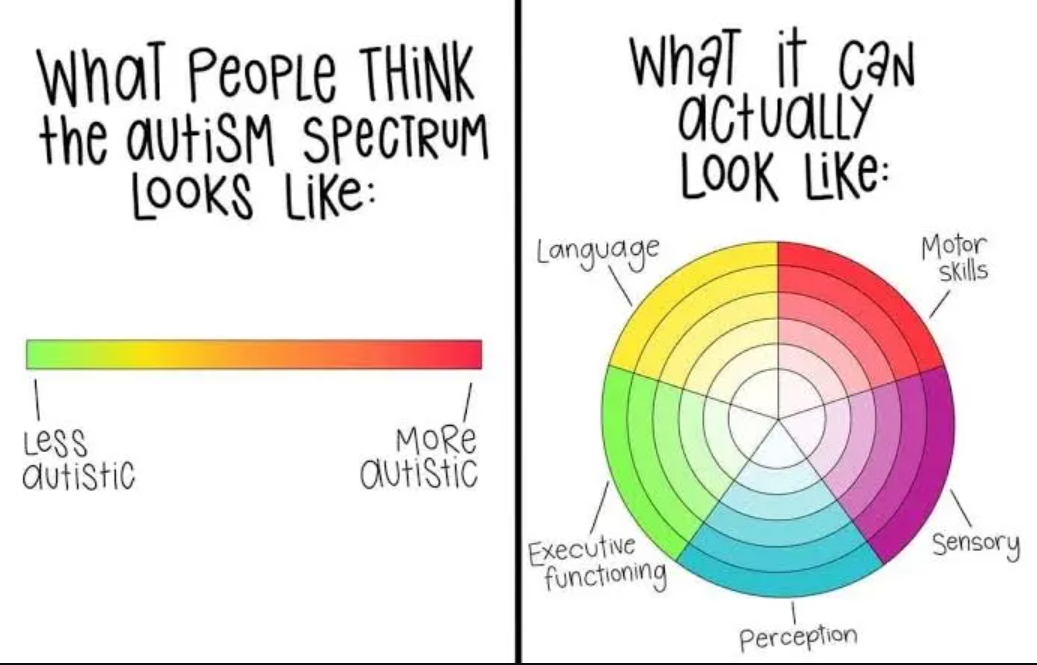
Understanding the Spectrum: What the Word "Spectrum" Means in Autism Spectrum Disorder
Autism Spectrum Disorder (ASD) is a neurodevelopmental disorder that affects communication, social interaction, and behaviour. The term "spectrum" is used to describe the range of symptoms and severity of the disorder, as well as the diversity of individuals with ASD. In this essay, we will explore what the word "spectrum" refers to in Autism Spectrum Disorder.
The Diversity of Autism
The word "spectrum" is used to describe the diversity of individuals with autism. Autism is not a one-size-fits-all disorder, and individuals with ASD can experience a wide range of symptoms and severity. Some individuals with autism may have difficulty with communication and social interaction, while others may have more subtle symptoms or may excel in certain areas, such as mathematics or music.
The Range of Symptoms
The word "spectrum" is also used to describe the range of symptoms that individuals with Autism Spectrum Disorder may experience. The symptoms of autism can vary greatly, even among individuals with the same diagnosis. Some common symptoms of autism include:
- Difficulty with social communication: Individuals with autism may have difficulty understanding nonverbal cues, such as facial expressions or body language. They may also have trouble initiating and maintaining conversations.
- Repetitive behaviours: Individuals with autism may engage in repetitive behaviours, such as rocking back and forth or repeating phrases or words.
- Sensory sensitivities: Many individuals with autism have sensory sensitivities, such as being overly sensitive to sounds, lights, or textures.
- Difficulty with transitions: Individuals with autism may have difficulty transitioning from one activity or task to another.
- Intense interests: Individuals with autism may have intense interests in specific topics or activities, and may spend a lot of time learning about or engaging in these interests.
- Difficulty with change: Individuals with autism may have difficulty with changes to their routine or environment, and may become upset or anxious in new situations.
The severity of these symptoms can vary widely, and individuals with autism may experience different combinations of symptoms. For example, one individual with autism may have difficulty with social communication but not exhibit any repetitive behaviours, while another individual may have intense interests but no sensory sensitivities.
The Diversity of Individuals with Autism
The word "spectrum" is also used to describe the diversity of individuals with autism. Individuals with autism come from all walks of life and may have a range of backgrounds, experiences, and abilities. The diversity of individuals with autism is reflected in the growing recognition of the importance of including diverse voices and perspectives in autism research and advocacy.
One way in which the diversity of individuals with autism is recognized is through the concept of neurodiversity. Neurodiversity refers to the idea that differences in brain function and behavior are normal and should be celebrated, rather than pathologized. The neurodiversity movement seeks to promote acceptance and inclusion of individuals with autism and other neurodivergent conditions, and to challenge the medical model of disability that views autism as a disorder to be treated or cured.
The Importance of Recognizing the Spectrum
Recognizing the spectrum of Autism Spectrum Disorder is important for several reasons
First, it helps to ensure that individuals with autism receive appropriate support and services that are tailored to their specific needs and strengths. By recognizing the diversity of symptoms and severity levels, healthcare professionals, educators, and caregivers can develop individualized treatment plans that address the unique needs of each person with autism.
Second, recognizing the spectrum of autism helps to reduce stigma and increase understanding of the disorder. Autism is often misunderstood or misrepresented in popular culture, which can lead to negative attitudes and discrimination towards individuals with autism. By recognizing the diversity of the disorder and the range of experiences that individuals with autism may have, we can work to promote acceptance and inclusion of people with autism.
Finally, recognizing the spectrum of autism is important for advancing research on the disorder. Researchers are beginning to recognize that autism is not a single disorder, but rather a complex network of biological and behavioural differences that can vary widely among individuals. By studying the range of symptoms and severity levels within the spectrum, researchers can gain a better understanding of the underlying biology and develop more effective treatments and interventions.
Technical Writer & Graphic Designer hos Scan A/S
11moIn continuation of this, autism is often misunderstood or misrepresented as most people associate autism with the movie Rainman. It can be difficult to describe that it is a complex network of biological and behavioral differences that can vary widely among individuals. It's possible that it's not entirely correct, but sometimes I think it's ok to use the word mild or difficult autism in relation to communication skills to briefly describe it to people who don't know about autism. But I think the most important thing is to spread and embrace the super qualities that autistics have instead of focusing on what they have difficulty with. Especially in the school and education system, there is a huge room for improvement. The autistic child cannot be cured or adapted to the system. It has to be reverse.